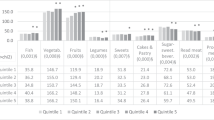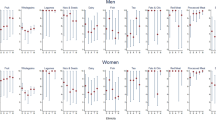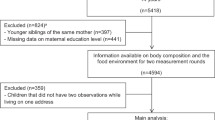Abstract
Objective:
To examine associations between seven indicators of socio-economic circumstances and healthy food habits, while taking into account assumed temporal order between these socio-economic indicators.
Design and setting:
Data were derived from cross-sectional postal questionnaires in 2000–2002. Socio-economic circumstances were assessed by parental education, childhood economic difficulties, own education, occupational class, household income, home ownership and current economic difficulties. Healthy food habits were measured by an index consisting of consumption of fresh vegetables, fruit or berries, rye bread, fish and choosing vegetable fats on bread and oil in cooking. Sequential logistic regression models were used, adjusting for age and marital status.
Participants:
Employees of the City of Helsinki, Finland (n=8960, aged 40–60 years).
Results:
Healthy food habits were reported by 28% of women and by 17% of men. Own education, occupational class, household income, home ownership and current economic difficulties were associated with healthy food habits. These associations were attenuated but mainly remained after mutual adjustments for the socio-economic indicators. Among women, a pathway was found suggesting that part of the effects of education on food habits were mediated through occupational class.
Conclusions:
Employees in higher and lower socio-economic positions differ in their food habits, and those in lower positions and economically disadvantaged are less likely to report healthy food habits. Health promotion programmes and food policies should encourage healthier food choices among those in lower socio-economic positions and among those with economic difficulties in particular.
Sponsorship:
Academy of Finland.
This is a preview of subscription content, access via your institution
Access options
Subscribe to this journal
Receive 12 print issues and online access
$259.00 per year
only $21.58 per issue
Buy this article
- Purchase on Springer Link
- Instant access to full article PDF
Prices may be subject to local taxes which are calculated during checkout
Similar content being viewed by others
References
Andrieu E, Darmon N, Drewnowski A (2006). Low-cost diets: more energy, fewer nutrients. Eur J Clin Nutr 60, 434–436.
Bartley M, Sacker A, Firth D, Fitzpatrick R (1999). Understanding social variation in cardiovascular risk factors in women and men: the advantage of theoretically based measures. Soc Sci Med 49, 831–845.
Bolton-Smith C, Smith WC, Woodward M, Tunstall-Pedoe H (1991). Nutrient intakes of different social-class groups: results from the Scottish Heart Health Study (SHHS). Br J Nutr 65, 321–335.
Braveman PA, Cubbin C, Egerter S, Chideya S, Marchi KS, Metzler M et al. (2005). Socioeconomic status in health research: one size does not fit all. J Am Med Assoc 294, 2879–2888.
Dalstra JA, Kunst AE, Borrell C, Breeze E, Cambois E, Costa G et al. (2005). Socioeconomic differences in the prevalence of common chronic diseases: an overview of eight European countries. Int J Epidemiol 34, 316–326.
Dalstra JA, Kunst AE, Mackenbach JP, the EU Working Group on Socioeconomic Inequalities in Health (2006). A comparative appraisal of the relationship of education, income and housing tenure with less than good health among the elderly in Europe. Soc Sci Med 62, 2046–2060.
Drewnowski A, Darmon N (2005). Food choices and diet costs: an economic analysis. J Nutr 135, 900–904.
Drewnowski A, Darmon N, Briend A (2004). Replacing fats and sweets with vegetables and fruits – a question of cost. Am J Public Health 94 (9), 1555–1559.
Dube SR, Felitti VJ, Dong M, Giles WH, Anda RF (2003). The impact of adverse childhood experiences on health problems: evidence from four birth cohorts dating back to 1900. Prev Med 37, 268–277.
Galobardes B, Davey Smith G, Lynch JW (2006). Systematic review of the influence of childhood socioeconomic circumstances on risk for cardiovascular disease in adulthood. Ann Epidemiol 16, 91–104.
Galobardes B, Lynch JW, Davey Smith G (2004). Childhood socioeconomic circumstances and cause-specific mortality in adulthood: systematic review and interpretation. Epidemiol Rev 26, 7–21.
Galobardes B, Morabia A, Bernstein MS (2001). Diet and socioeconomic position: does the use of different indicators matter? Int J Epidemiol 30, 334–340.
Galobardes B, Shaw M, Lawlor DA, Lynch JW, Davey Smith G (2006a). Indicators of socioeconomic position (part 1). J Epidemiol Commun Health 60, 7–12.
Galobardes B, Shaw M, Lawlor DA, Lynch JW, Davey Smith G (2006b). Indicators of socioeconomic position (part 2). J Epidemiol Commun Health 60, 95–101.
Giskes K, Kunst AE, Benach J, Borrell C, Costa G, Dahl E et al. (2005). Trends in smoking behaviour between 1985 and 2000 in nine European countries by education. J Epidemiol Community Health 59, 395–401.
Giskes K, Lenthe FvF, Brug HJ, Mackenbach J (2004). Dietary intakes of adults in the Netherlands by childhood and adulthood socioeconomic position. Eur J Clin Nutr 58, 871–880.
Giskes K, Turrell G, Patterson C, Newman B (2002). Socioeconomic differences among Australian adults in consumption of fruit and vegetables and intakes of vitamins A, C and folate. J Hum Nutr Diet 15, 375–385. discussion 387–390.
Grabauskas V, Petkeviciene J, Kriaucioniene V, Klumbiene J (2004). Health inequalities in Lithuania: education and nutrition habits. Medicina (Kaunas) 40, 875–883.
Groth MV, Fagt S, Brøndsted L (2001). Social determinants of dietary habits in Denmark. Eur J Clin Nutr 55, 959–966.
Hagenaars A, de Vos K, Zaidi M (1994). Poverty Statistics in the Late 1980s: Reasearch Based on Micro-Data. Office for Official Publications of the European Communities: Luxembourg.
Hulshof KF, Brussaard JH, Kruizinga AG, Telman J, Löwik MR (2003). Socio-economic status, dietary intake and 10 y trends: the Dutch National Food Consumption Survey. Eur J Clin Nutr 57, 128–137.
Hulshof KF, Lowik MR, Kok FJ, Wedel M, Brants HA, Hermus RJ, ten Hoor F (1991). Diet and other life-style factors in high and low socio-economic groups (Dutch Nutrition Surveillance System). Eur J Clin Nutr 45, 441–450.
Irala-Estévez JD, Groth M, Johansson L, Oltersdorf U, Prättälä R, Martínez-González MA (2000). A systematic review of socio-economic differences in food habits in Europe: consumption of fruit and vegetables. Eur J Clin Nutr 54, 706–714.
Johansson L, Thelle DS, Solvoll K, Bjorneboe GA, Drevon CA (1999). Healthy dietary habits in relation to social determinants and lifestyle factors. Br J Nutr 81, 211–220.
Kestilä L, Koskinen S, Martelin T, Rahkonen O, Pensola T, Aro H et al. (2006). Determinants of health in early adulthood: what is the role of parental education, childhood adversities and own education? Eur J Public Health 16, 306–315.
Kirkpatrick S, Tarasuk V (2003). The relationship between low income and household food expenditure patterns in Canada. Public Health Nutr 6, 589–597.
Kivimäki M, Davey Smith G, Juonala M, Ferrie JE, Keltikangas-Järvinen L, Elovainio M et al. (2006a). Socioeconomic position in childhood and adult cardiovascular risk factors, vascular structure and function: the Cardiovascular Risk in Young Finns Study. Heart 92, 474–480.
Kivimäki M, Lawlor DA, Davey Smith G, Keltikangas-Järvinen L, Elovainio M, Vahtera J et al. (2006b). Early socioeconomic position and blood pressure in childhood and adulthood: the Cardiovascular Risk in Young Finns Study. Hypertension 47, 39–44.
Krieger N, Okamoto A, Selby JV (1998). Adult female twins' recall of childhood social class and father's education: a validation study for public health research. Am J Epidemiol 147, 704–708.
Krieger N, Williams DR, Moss NE (1997). Measuring social class in US public health research: concepts, methodologies, and guidelines. Annu Rev Public Health 18, 341–378.
Laaksonen M, Prättälä R, Helasoja V, Uutela A, Lahelma E (2003). Income and health behaviours. Evidence from monitoring surveys among Finnish adults. J Epidemiol Commun Health 57, 711–717.
Laaksonen M, Rahkonen O, Karvonen S, Lahelma E (2005a). Socioeconomic status and smoking: Analysing inequalities with multiple indicators. Eur J Public Health 15, 262–269.
Laaksonen M, Rahkonen O, Martikainen P, Lahelma E (2005b). Socioeconomic position and self-rated health: the contribution of childhood socioeconomic circumstances, adult socioeconomic status, and material resources. Am J Public Health 95, 1403–1409.
Lahelma E, Martikainen P, Laaksonen M, Aittomäki A (2004). Pathways between socioeconomic determinants of health. J Epidemiol Commun Health 58, 327–332.
Lahelma E, Martikainen P, Rahkonen O, Roos E, Saastamoinen P (2005). Occupational class inequalities across key domains of health: results from the Helsinki Health Study. Eur J Public Health 15, 504–510.
Lallukka T, Aittomäki A, Piha K, Roos E, Kivel K, Silventoinen K (2002). Postikyselytutkimukseen vastanneiden edustavuus sosioekonomisten tekijöiden ja sairauspoissaolojen mukaan: Helsingin kaupungin henkilöstön terveystutkimus. (Associations of socio-economic factors and sickness absence with participation in a health survey. The Helsinki Health Study). Sosiaalilääk Aikakausl 39, 164–171.
Lallukka T, Sarlio-Lähteenkorva S, Roos E, Laaksonen M, Rahkonen O, Lahelma E (2004). Working conditions and health behaviours among employed women and men: the Helsinki Health Study. Prev Med 38, 48–56.
Lantz PM, House JS, Lepkowski JM, Williams DR, Mero RP, Chen J (1998). Socioeconomic factors, health behaviors, and mortality: results from a nationally representative prospective study of US adults. J Am Med Assoc 279, 1703–1708.
Liberatos P, Link B, Kelsey J (1988). The measurement of social class in epidemiology. Epidemiol Rev 10, 87–121.
Lynch J, Kaplan G (2000). Socioeconomic position. In: Berkman LF, Kawachi I (eds.) Social Epidemiology. Oxford University Press: New York. pp. 13–35.
Macintyre S (1997). The Black Report and beyond: what are the issues? Soc Sci Medi 44, 723–745.
Macintyre S, Ellaway A, Der G, Ford G, Hunt K (1998). Do housing tenure and car access predict health because they are simply markers of income or self esteem? A Scottish study. J Epidemiol Commun Health 52, 657–664.
Mäkinen T, Laaksonen M, Lahelma E, Rahkonen O (2006). Associations of childhood circumstances with physical and mental functioning in adulthood. Soc Sci Med 62, 1831–1839.
Martikainen P, Brunner E, Marmot M (2003). Socioeconomic differences in dietary patterns among middle-aged men and women. Soc Sci Med 56, 1397–1410.
Naska A, Fouskakis D, Oikonomou E, Almeida MD, Berg MA, Gedrich K et al. (2006). Dietary patterns and their socio-demographic determinants in 10 European countries: data from the DAFNE databank. Eur J Clin Nutr 60, 181–190.
National Nutrition Council (1998). Finnish Nutrition Recommendations. Committee report, Ministry of Agriculture and Forestry: Helsinki.
Perrin AE, Simon C, Hedelin G, Arveiler D, Schaffer P, Schlienger JL (2002). Ten-year trends of dietary intake in a middle-aged French population: relationship with educational level. Eur J Clin Nutr 56, 393–401.
Prättälä R, Berg MA, Puska P (1992). Diminishing or increasing contrasts? Social class variation in Finnish food consumption patterns, 1979–1990. Eur J Clin Nutr 46, 279–287.
Roos E, Lahelma E, Virtanen M, Prättälä R, Pietinen P (1998). Gender, socioeconomic status and family status as determinants of food behaviour. Soc Sci Med 46, 1519–1529.
Roos E, Sarlio-Lähteenkorva S, Lallukka T (2004). Having lunch at a staff canteen is associated with recommended food habits. Public Health Nutr 7, 53–61.
Shahar D, Shai I, Vardi H, Shahar A, Fraser D (2005). Diet and eating habits in high and low socioeconomic groups. Nutrition 21, 559–566.
Shariff ZM, Khor GL (2005). Obesity and household food insecurity: evidence from a sample of rural households in Malaysia. Eur J Clin Nutr 59, 1049–1058.
Sundquist J, Johansson SE (1997). Indicators of socio-economic position and their relation to mortality in Sweden. Soc Sci Med 45, 1757–1766.
Turrell G, Hewitt B, Patterson C, Oldenburg B (2003a). Measuring socio-economic position in dietary research: is choice of socio-economic indicator important? Public Health Nutr 6, 191–200.
Turrell G, Patterson C, Oldenburg B, Gould T, Roy MA (2003b). The socio-economic patterning of survey participation and non-response error in a multilevel study of food purchasing behaviour: area- and individual-level characteristics. Public Health Nutr 6, 181–189.
Wilcosky T, Wing S (1987). The healthy worker effect. Selection of workers and work forces. Scand J Work Environ Health 13, 70–72.
Acknowledgements
The ongoing Helsinki Health Study is supported by Grants from the Academy of Finland (no. 53245, no. 105812, no. 205588, no. 210435, no. 204894) and the Finnish Work Environment Fund (no. 103310). We thank the City of Helsinki and all members of the Helsinki Health Study group for their contribution.
Author information
Authors and Affiliations
Corresponding author
Additional information
Guarantor: T Lallukka.
Contributors: The above authors declare to have participated in the planning of the analyses and reviewing and commenting of the manuscript and to have seen and approved the final version.
Rights and permissions
About this article
Cite this article
Lallukka, T., Laaksonen, M., Rahkonen, O. et al. Multiple socio-economic circumstances and healthy food habits. Eur J Clin Nutr 61, 701–710 (2007). https://doi.org/10.1038/sj.ejcn.1602583
Received:
Revised:
Accepted:
Published:
Issue Date:
DOI: https://doi.org/10.1038/sj.ejcn.1602583
Keywords
This article is cited by
-
Influence of education and subjective financial status on dietary habits among young, middle-aged, and older adults in Japan: a cross-sectional study
BMC Public Health (2023)
-
Disparities in fruit and vegetable intake at the intersection of gender and education in northern Sweden: a cross-sectional study
BMC Nutrition (2022)
-
The association of knowledge, attitudes and behaviors related to salt with 24-h urinary sodium, potassium excretion and hypertensive status
Scientific Reports (2022)
-
Risk factors related with high sodium intake among Malaysian adults: findings from the Malaysian Community Salt Survey (MyCoSS) 2017–2018
Journal of Health, Population and Nutrition (2021)
-
Shifts towards healthy diets in the US can reduce environmental impacts but would be unaffordable for poorer minorities
Nature Food (2021)



